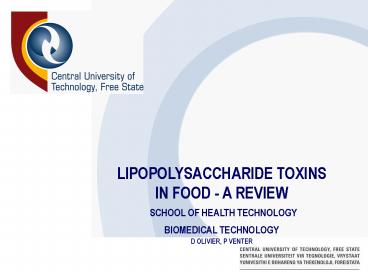LIPOPOLYSACCHARIDE TOXINS - PowerPoint PPT Presentation
1 / 16
Title:
LIPOPOLYSACCHARIDE TOXINS
Description:
Foodborne diseases influence the health of individuals and the ... of extrinsic and intrinsic factors thereon have been published in the last few decades ... – PowerPoint PPT presentation
Number of Views:342
Avg rating:3.0/5.0
Title: LIPOPOLYSACCHARIDE TOXINS
1
LIPOPOLYSACCHARIDE TOXINS IN FOOD - A REVIEW
SCHOOL OF HEALTH TECHNOLOGY BIOMEDICAL
TECHNOLOGY D OLIVIER, P VENTER
2
INTRODUCTION
- Foodborne diseases influence the health of
individuals and the development of societies - Microbial pathogens contaminate food and water
supplies - The WHO defines food hazards as biological,
chemical, or physical agents in or property of
food that may have an adverse health effect,
3
FOOD SAFETY
- Food safety is non-negotiable
- Food safety all conditions and measures that
are necessary during the production, processing,
storage, distribution and preparation of food to
ensure that it is safe, sound, wholesome and fit
for human consumption - The food industry is in constant battle with
inevitable microbial contamination
4
FOOD SAFETY (CONTINUE)
- Endotoxin (ET) release is poorly understood
- Highlight the importance of possible endotoxin
release due to food preservation - The pharmaceutical industry invests more
resources into quality control and product safety
5
LIPOPOLYSACCHARIDES (LPS)
- The LPS is an integral part of the outer membrane
of Gram-negative bacteria - Participate in the interaction of the bacterial
cell with possible hosts and with the extrinsic
environment. - Are continuously liberated into the environment
when the cells die, and during cell growth and
division - Many of the pathophysiological consequences of
infection by Gram negative bacteria can be
attributed to the activities of LPS as an ET
6
STRUCTURE OF LPS
- Three separate regions
- Lipid A is the highly hydrophobic and
endotoxically active part of the molecule. - The core section of the molecule, which is
covalently attached to lipid A - Polymer of repeating subunits called the
O-polysaccharide (O-chain)
7
STRUCTURE OF SALMONELLA LPS
8
LPS IN FOOD AND FOOD PROCESSING ENVIRONMENT
- Little is known about the role of LPS in the
survival of Gram-negative bacteria in food and
the food processing environment - A parallel between the resistance of
microorganisms and the efficacy of the sanitation
processes in the food manufacturing industry is
known to exist and is a direct result of the
inherent ability of bacteria to adapt to a new
environment and form increasingly resistant
survival structures such as biofilms
9
LPS IN FOOD AND FOOD PROCESSING ENVIRONMENT
(CONTINUE)
- Biofilm is recognised as a notable product safety
hazard. - Biofilm formation is a complex process, whose
initial step is the adhesion of bacteria to a
surface - LPS play an important role in this process
- Biofilm are considered to be highly resistant to
antimicrobial agents
10
ET QUANTIFICATION
- Several methods have been developed during the
last few decades for the quantification and
qualification of endotoxins in both food and
dairy products. - These methods are categorised under pyrogen
detection, immunological, chromatographic and
electrophoretic methods. - The Limulus method proved to be accurate and
sensitive
11
SANITIZERS AND LPS TOXICITY
- Several papers on the O-antigen ultra-structure
and the influence of extrinsic and intrinsic
factors thereon have been published in the last
few decades - Little mention has however been made of the
influence of sanitizers applied in the food
industry on the LPS structure
12
SANITIZERS AND LPS TOXICITY (CONTINUE)
- LPS derived from E. coli O111 treated with a
heavy-duty alkaline sanitizer had a change in
toxicity per OD620nm higher than all the
remaining treated LPSs including the control LPS - The phenolic hand wash solution also resulted in
a slight increase in toxicity, - CIP chlorinated sanitizer reduced the toxicity
compared to the control.
13
SANITIZERS AND LPS TOXICITY (CONTINUE)
- The lipid A section of the LPS has been shown to
constitute the endotoxic principle of LPS and
therefore the mentioned change in the toxicity
was expected to be reflected in the lipid A
composition. - This, however, did not seem to be the case for E.
coli O111 as no correlation was noted with the
toxicity. - Weber-Frick and Schmidt-Lorenz (1988) who
mentioned that any change in not only the lipid A
but the entire O-polysaccharide structure would
influence the results obtained by the LAL assay.
14
CONCLUSION
- Kauffmann established a viable serotyping scheme,
which is still accepted internationally today - Rapid serotyping kits assess the O-antigen
presence are readily available
15
CONCLUSION (CONTINUE)
- LPS heterogeneity affect various cell surface
properties - Application of sanitizers in the food production
environment should be carefully planned - Doubtful whether the LAL assay will be an
accurate method to verify the quantity of E. coli
O111 - Effect of HPP and HHP
16
- THANK YOU

